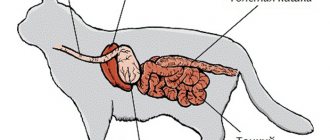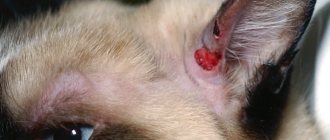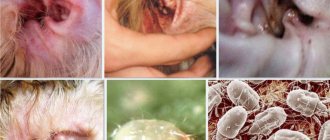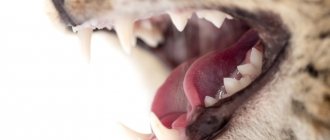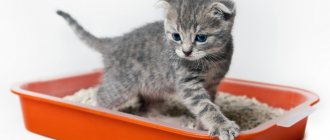4305Pavel
Every veterinarian knows how to treat a fistula in a cat, but for the owner such a health problem in a pet poses great difficulties. A fistula is a canal that connects an internal organ (mostly hollow) with the external environment. A canal that connects two cavities is also called a fistula. Such channels are not natural, but pathological, arising against the background of various diseases. The inner surface of the fistula can be lined with epithelial or wound tissue. Outwardly, it most often looks like a freshly opened abscess on a cat.
Often, confusing a fistula with an abscess, owners begin to self-medicate the cat, which ultimately only aggravates the condition of the sick animal. In severe cases, improper treatment and refusal to seek help from veterinarians lead to the death of the cat. The main complication that occurs against the background of a fistula is sepsis. If the blood is infected, it is almost impossible to save an animal even in the conditions of the most modern veterinary clinic.
© shutterstock
At the slightest suspicion of the presence of a pathological phenomenon, you should urgently show your pet to a veterinarian. Only a specialist can carry out the correct treatment and restore the cat’s health.
general information
A fistula (or fistula) is a through channel connecting an internal hollow organ with the external environment (external type) or two cavities between each other (internal type). Its walls can be lined with epithelial or granulation (wound) tissue. In appearance, the fistula may resemble a burst abscess. Therefore, owners who see a wound on their animal decide that they can cope with the disease at home and do not contact the veterinary service, thereby aggravating it.
Only a veterinarian can make the correct diagnosis. And this is very important, because if the fistula is not treated, it can be complicated by sepsis, which will lead to the death of the cat.
Saculectomy
This operation to remove the paraanal sinuses is performed in dogs in cases where inflammation and abscesses recur more often than once every 1-2 years. In principle, in healthy dogs the paraanal glands do not become inflamed so often. Therefore, a complete examination is necessary before surgery.
Paraanal sinuses also have to be removed in dogs that require weekly gland emptying.
Saculectomy is performed under general anesthesia. After the operation, daily treatments and wearing protective underwear (pants) are required.
Varieties of the disease
Fistulas have several varieties depending on the following factors:
- localization locations;
- the reasons that caused the pathology.
Depending on the location and the fluid released
- Purulent fistulas are a means of draining pus from the source of the inflammatory process located deep inside.
- Urinary fistulas occur on the organs of the genitourinary system (ureter, bladder, urethra). The cause is most often injury.
- Intestinal - affects the upper part of the small intestine and appears as a result of intestinal obstruction, injury or unsuccessful surgery.
- Fistulas in the large intestine are localized in the lower abdomen. They drain feces and occur after injury or surgery.
- Biliary fistulas allow the passage of bile after unsuccessful surgery or as a result of injury. This is a very traumatic type of fistula, since the surrounding tissues are constantly inflamed as a result of contact with its aggressive contents.
- Salivary fluid is the result of inflammatory processes in the area of the roots of the teeth, ears, and cheeks.
Depending on the cause
According to their origin, fistulas are divided into two types:
- congenital (arise as a result of some defects in intrauterine development);
- acquired (arise as a result of injuries, complications after surgery, and various purulent processes).
Congenital fistulas
A congenital fistula is a straight or curved canal, lined from the inside with healthy epithelial tissue, through which there is an outflow of various biological fluids (saliva, urine, feces), depending on which organ is affected.
Presumable causes of the appearance of congenital fistulas are some kind of developmental disorders of the fetus, intrauterine infections when the mother’s immunity decreases while carrying kittens.
Congenital fistulas can be localized on the nose, neck, navel and other places. The most common is the so-called umbilical duct. This is a canal that connects a newborn baby's navel with his abdominal cavity. This type of fistula in itself is not dangerous. But the kitten can get sick, since the canal becomes a gateway for pathological microflora to enter.
Acquired fistulas
An acquired or pathological fistula is a canal lined with hyperemic granulation tissue. It can be the result of injuries (penetrating wounds and open fractures), complications after operations and advanced purulent processes:
- A fistula resulting from a penetrating wound is caused by a deep infected wound.
- A fistula that occurs as a result of tissue damage from bone fragments during treatment of a fracture will gradually close on its own.
- A fistula as a result of a complication of surgical interventions indicates that during the operation or suturing the rules of asepsis and antisepsis were violated, which led to tissue infection and inflammation.
- Advanced purulent processes. Their causes are unsuccessful attempts to cure abscesses or other inflammatory diseases at home. The progression of the process led to a large accumulation of purulent masses seeking outflow.
A dangerous type of fistula in cats is a fecal fistula in the large intestine. It may appear after sterilization or castration of animals carried out in violation. Its contents are feces, which creates a high risk of infection of surrounding tissues and, ultimately, can lead to purulent peritonitis and death.
Causes
The cause of a fistula is often trauma, chronic inflammation, or abnormal intrauterine development.
Depending on the cause of formation, fistulas are:
- Acquired - appear after injury, surgery, development of purulent processes. For example, pathology can occur after sterilization of a cat due to improper use of antiseptics, or with advanced periodontal disease with the subsequent development of an abscess. Other causes of acquired fistula are gunshot wounds, necrotic bone fragments after a complex fracture.
- Congenital - occur as a result of abnormal intrauterine development. The canal is covered with epithelium, and biological fluid leaks through the hole - bile, saliva, urine. Common congenital fistulas include the umbilical one. It appears when the birth is performed incorrectly, or when the animal bites the umbilical cord too close. Penetration of infection through such a channel threatens the development of serious health problems in the kitten.
Fistula and abscess: what is the difference
In appearance, the fistula may resemble a burst abscess (abscess). But there are also differences that the owner must be aware of so as not to confuse these two diseases and not waste time. After all, their treatment should be radically different.
Abscess symptoms
An immature abscess has a dense consistency, the skin on it is tense and hot. After opening, it seems to “deflate”, becoming soft and loose. It has a round hole with smooth edges, from which pus is released after ripening. The opened abscess begins to heal quite quickly.
Symptoms of a fistula
The external fistula has an opening in the form of a deep funnel, sometimes with heavily hyperemic edges. Depending on the location, pus, urine, feces, saliva or bile are released. The fistula does not heal on its own. The owner should be alerted to the fact that liquid is constantly oozing from the wound, and the fur around it is stuck together from the discharge. Another symptom is an unpleasant odor.
An internal fistula is formed after suffering from inflammatory diseases of the internal organs. In the initial stages there are no symptoms, which makes its timely diagnosis difficult. Such fistulas have to be diagnosed at an advanced stage, when treatment may not be successful.
What are paraanal glands and what function do they perform in dogs?
Paraanal glands are symmetrical sacs located on the side of the rectum in the area of its transition to the anus. With their participation, a secretion is produced that emits an intense odor. It is needed for the following purposes:
- Territory marker.
- Facilitation of bowel movements.
Typically, the glands constantly cleanse themselves due to compression when stool is released. In some cases, they become clogged and the secretion does not come out naturally. Because of this, the inflammatory process begins. The pet requires medical attention or owner intervention.
Diagnosis of the disease
If you suspect that your pet has a fistula, the owner should contact a veterinarian as soon as possible, without waiting for complications. The doctor takes the following diagnostic measures:
- external examination, collection of anamnestic data;
- magnetic resonance or ultrasound examination of the affected area;
- blood chemistry;
- identification of concomitant diseases;
- When the fistula is localized on the back, there is usually a suspicion of a malignant tumor. In this case, a biopsy is prescribed.
Treatment of the disease
Owners who notice a fistula in their cat should know how to treat it. Unfortunately, fistula is a disease that can only be treated surgically. Therapy includes four stages:
- Having reached the source of inflammation, the surgeon eliminates it, simultaneously removing necrotic tissue. This is the most important step, since otherwise the treated fistula will recur. If its top layer is lined with epithelium (congenital type), then healing will not take place without removing the top layer.
- A medical drain is installed near the fistula to direct the outflow of fluid through it, freeing the pathological duct.
- The surgeon then cleans the fistula, removing inflamed tissue, rinses and disinfects it.
- Restorative treatment consists of regular rinsing of the canal, applying a bandage with healing ointments and prescribing antibiotics to prevent complications.
If the fistula exists for quite a long time, then its walls become coarser and can no longer heal on their own. In this case, they are excised and stitched for speedy fusion.
How to clean a dog's glands at home?
There are two methods of sanitation. Algorithm for an option that is easy to do yourself:
- If the process takes place along with bathing, the pet is left in the bathroom. Raise the tail with your hand and move it up towards your back. This will cause the muscles to relax and the ducts to open.
- Place a paper handkerchief on the anus, gently press on all sides of the anal sphincter. The secret will be on the napkin. Then you can wash your pet, then apply Vaseline to the anus area.
- If during the process there is restless behavior, pain or cracks and redness of the sphincter, it should be treated with ointment (synthomycin liniment). For the next three to four days, you will need to use rectal ichthyol suppositories.
The second method is usually used by veterinarians, since it will be possible to immediately palpate the paraanal glands for diagnostic purposes. It is important to provide protection by wearing a rubber glove.
- Apply Vaseline oil to the anus and fingers.
- Send your index finger into the rectum and grab the skin near the sphincter with your thumb. Using gentle massage movements, press down on both sides in turn.
- Wipe the affected area with a paper handkerchief previously dipped in chlorhexidine. Use rectal ichthyol suppositories for three to four days. It is better to start the procedure after the pet has finished defecating.
- After defecation, the dog's anus should be treated with a chlorhexidine wipe. This is quite simple and prevents possible inflammation.
Video: inflammation of the paraanal glands in dogs: symptoms and treatment
Prevention measures
Prevention of fistulas involves regular medical examination of animals. After all, a disease noticed in time has every chance of being cured. In case of injury and fractures, care must be taken to ensure that the wounds heal completely and that the fractures heal without complications.
It is necessary to take measures to ensure that the cat’s body resistance is at a high level. This is facilitated by high-quality cat food, enriched with vitamins and microelements, a calm environment, active games, and timely control of parasites. After all, a strong immune system is a reliable protection against many ailments and unpleasant complications.
Why can this organ become inflamed?
According to many experts, in modern pets the glands are a vestigial organ. During the process of evolution, it stopped working correctly. Because of this, stagnation of the secretion often occurs.
If the animal has a balanced diet and regularly goes for walks, the disease rarely occurs. The pathology affects dogs that move little and have digestive problems.
Other causes of inflammation:
- Genetic predisposition. Typically, pathology is diagnosed in representatives of small breeds, such as Pekingese, dachshund, bulldog, and pug.
- Obesity. Overweight dogs are at risk and require cleaning for prevention.
- Lack of control over the condition of the glands, especially for decorative breeds.
- Weak immune system.
- Injuries near the anus, bacterial insemination.
- Presence of bones in the diet.
- Neglect of water procedures.
- A large amount of protein on the menu.
- Frequent matings.
- Infectious pathologies.
- Pregnancy period.
